
Treat the Earth like an ailing deity
The Russian artist Pavel Pepperstein on defending the environment from the insane human race
28/10/2019
A standout representative of the younger generation of the Moscow romantic conceptualism, one of the founding members of the Inspection Medical Hermeneutics art group, the ideologist of the psychedelic realist movement, contributor to more than a hundred exhibitions worldwide, including the Venice Biennale and Manifesta, Kandinsky Prize winner Pavel Pepperstein is known not only as an artist whose works are held in the collections of the Russian Museum, Tretyakov Gallery, Louvre and Centre Pompidou or the author of phantasmagorical literary bestsellers, but also as an art theorist, rapper and even a couturier.
It was long before the fateful speech by the Swedish climate activist Greta Thunberg at the 74th Session of the UN General Assembly that Arterritory suggested that I speak with him about ‘planet detox’, the involvement of art in the environmental movement, eco-futurism, etc., etc. After spending some time exploring the subject, I realised that things were really bad and only a miracle could save us ‒ apropos of which I suddenly remembered an old story.
During the 1970s and 1980s, I lived with my family in an artist co-operative in Festivalnaya Street. It was home to an excellent community of talents, including Ilya Kabakov, Viktor Pivovarov and Eduard Gorokhovsky; my ‒ literally ‒ next-door neighbours were the poet and artist Irina Pivovarova and, accordingly, her son Pasha (Pavel). Many years later, while leafing through an old issue of The Prime Russian Magazine, God rest its soul, a publication dedicated to the existence of miracles in our everyday life, I stumbled on Pasha Pepperstein’s statement that, ‘with greater or smaller success’, everybody can count on a miracle. He explained then that, as a boy, after learning of prayer as a means of obtaining one’s object of desire, he had turned to God, asking Him for baby weighing scales, the type he had seen at the polyclinic. He said a prayer before bed; the following morning, as he was leaving his flat for school, Pasha found scales of exactly the right kind waiting for him in the communal passage. He went on to describe his shock, delight, desire to take the scales at once and his elders’ emphatic objections.
I put two and two together and realised that those must have been my scales. Or, to be precise, not exactly mine: they were lent me for weighing my new-born son. I left the scales in the communal passage for a few days because they needed to be washed properly before they could be brought in.
I had long wanted to tell the protagonist of these events the whole story; I decided now that the time had come and that one would be hard-pressed to come up with a better opening to a conversation about karmic connections, the future awaiting us, environmental agenda and even creative plans.
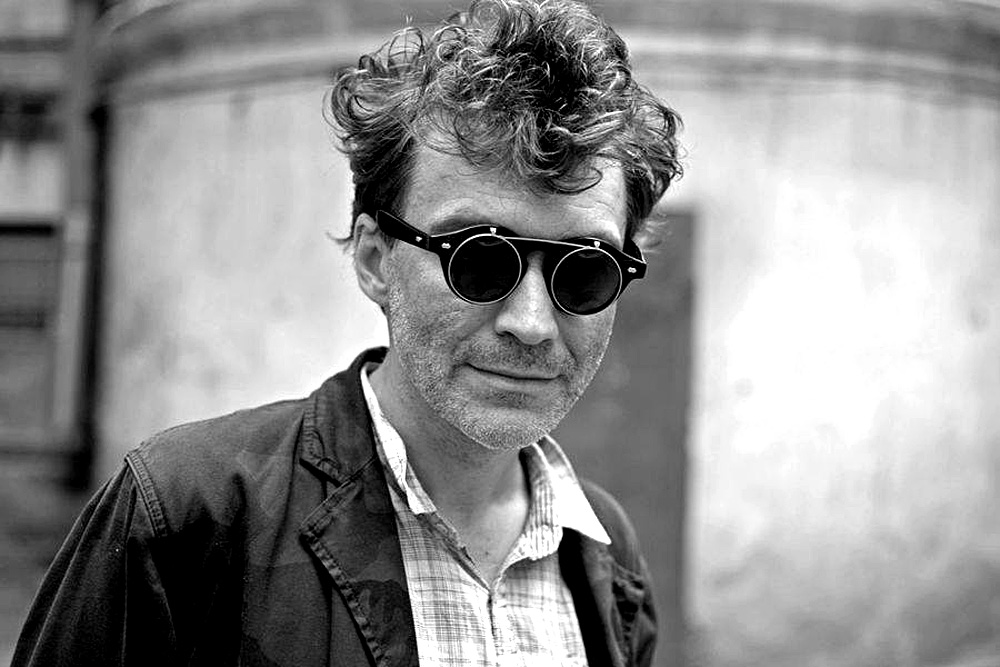
Pavel Pepperstein
How do you like this twist in the storyline, Pasha?
This is incredible, this is brilliant ‒ the story unexpectedly found its epilogue.
Am actual fact can always be interpreted in various ways. It can either disappoint or delight. At the time, I found it striking ‒ also, yet another proof of divine predestination. I confirmed for myself that prayers were answered, but I also felt a bit intimidated. It was as if I had been shown that one should not treat it as a game. What nonsense: you wanted scales ‒ here, take your scales. So you could say that I was delighted but I also felt that I had received a bit of warning.
But could it be that, moving through a very familiar space, you had recorded the presence of the object unconsciously, with peripheral vision, and that is why it came to you at the right moment? Like the anticipatory events that Andrei Monastyrski refers to in his Aesthetic Studies.
No, I don’t think that I had seen the scales in the building. It was much earlier, at the polyclinic, that I had been charmed by this thing. I thought the scales were a truly beautiful object; the tiny weights moving along the metallic scale, all the various thingies ‒ I found all of that wonderful. For some reason, I was fascinated by that kind of objects as a child, and that’s why I asked for the scales after a visit to the doctor’s. But this is incredible; I never expected this story I found so completed to continue in any way.
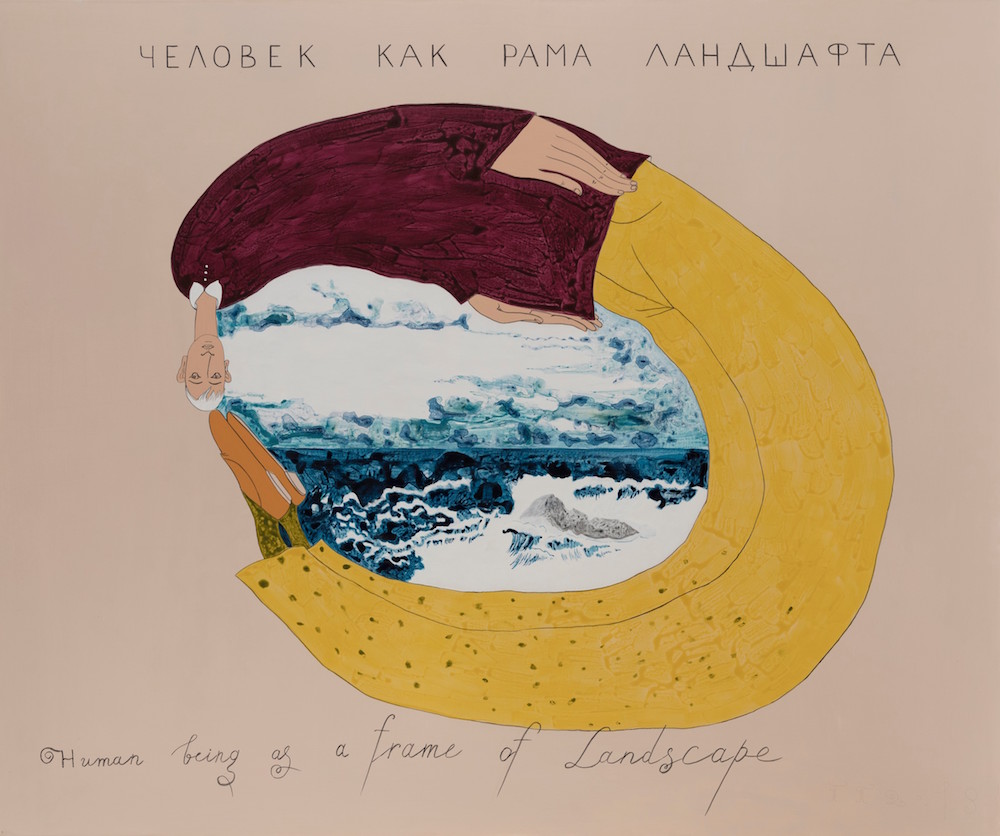
Pavel Pepperstein. Human being as a frame of Landscape. 2018. Acrylic, canvas
It turns out that a continuation is always possible, even under the most unobvious circumstances. And this is exactly the right moment to turn to the main story of our conversation and try and understand what to expect in these times of global climate change: is it worth hoping for a continuation of tolerable existence on Earth and what is the role of miracles, art and artists in all this? In 2015, you took part in the Artists 4 Climate initiative that saw fourteen artists present their projects during the Paris Climate Change Conference. Why did the initiative attract your attention?
While I may not be, in some other cases, a socially responsible artist, problems of ecology have always mattered to me. I have even been driven to morbid frenzy or excitement on some occasions. I have periodically been inspired to do something about it; I’ve wanted to contribute in some way, to do something good, because that is the one thing I find the most significant. I did attempt to do something in my somewhat chaotic way. For instance, at some point I offered my services as an artist to Greenpeace. For free, of course. To which they politely said that they would accept mu help with pleasure but that I needed to find my ways of being ecologically creative on my own. Whereas I had hoped to be given immediate specific tasks, like commission for posters or something like that. I did not get any commissions, and I stalled; nothing coherent came out of it. I remember being incredibly stricken by the disaster in the Gulf of Mexico, when after an explosion on a British Petroleum drilling rig tonnes of raw oil ended up spilling in the ocean, which resulted in the death of countless birds, fish, animals. I painted the Oil Spills in the Ocean series then. But I realised later that I could not benefit the cause in any particular way, apart from donating money to environmental projects, which I did occasionally. Nevertheless, when I heard about the ecological forum, or, to be precise, heard about it in the form of proposal, I accepted it.
You mean they found you and invited you?
Yes, and initially it looked like quite a grand project. Participants and guests of the forum were supposed to be greeted with environmentally themed works of art at the Paris Charles de Gaulle Airport. There were negotiations about a big mosaic, a mural or a sculpture, but it came to nothing ‒ the whole thing was too expensive. But I did contribute in some way, although, to be fair, I don’t even remember the result very well.
You had this story of cloud airplanes and flying shells. There was something about an unusual fuel ‒ jelly-like, transparent, but exceptionally strong material, permeated with nano-capillaries. An almost life-size model of this unique aircraft was supposed to be exhibited in the airport lounge, and passengers ‒ real passengers ‒ could download a novel written by you on their devices. And then these passengers, departing to every part of the world, were supposed to read the novel and imagine an environmentally clean existence, filled with every kind of new incredible technologies. The story was set in distant future.
Exactly, in distant future ‒ regretfully. Whereas I, living in that particular present, realised that I can’t do anything about it. The subject proved too painful for me; I felt a certain wobbliness of my mental state and decided to drift away from the whole thing.
But things have changed recently. I watched the much-discussed address by the young Swedish girl Greta Thunberg and it made me feel ecstatic. I subscribe to every word she said. I wanted to say pretty much the same thing back in the noughties, but I am just a cowardly and spineless gentleman, not a courageous sixteen-year old girl.
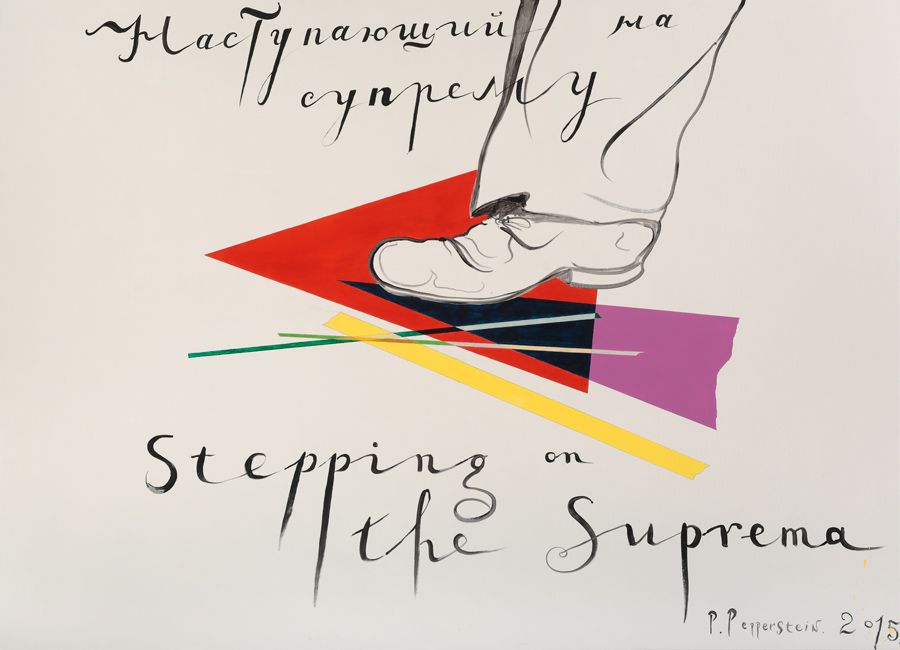
Pavel Pepperstein. Stepping on the Supreme. 2015. Acrylic, canvas
With Asperger’s and some other problems.
With a condition that gives her courage, directness and obstinacy, qualities that are completely necessary in this instance. And now I have a hope.
One of my stories about the future says that the healing of the Earth takes place through handing over power over the planet to girls with Down’s syndrome. See? I only didn’t get the exact condition right.
Greta matters first of all because she defines the problem in a very exact way. She is completely right when she says that you cannot assemble and discuss some sort of complete nonsense in face of an actually important problem that needs immediate solution. I’m not trying to say that no-one is trying to solve environmental problems ‒ not at all. There are even some important breakthrough moments. For instance, someone has developed a plastic-eating bacterium. We must try it out at once on the plastic islands that float in the ocean.
Why is it then that no-one is keen to listen to experts but Greta’s speech caused such a stir?
Legions of experts say their bit every day, and then other experts come forward and present other data, and everything remains in an area of sameness. Whereas Greta speaks in the spirit of Andersen’s child who yells this thing about the naked emperor. In this case, however, she is yelling about the king dying, not about him being naked. He is dying, save him, because we are all going to die along with him. Did not Søren Kierkegaard say back in his time that a sixteen-year old girl is a direct representation of the Lord? So I think it is worth listening to what she has to say.

Pavel Pepperstein. Zeitgeist. From the series “Philosophical Categories”. 2018. Oil, canvas
How do you respond to the fact that many people are outraged by Greta’s speech and declare that serious problems cannot be solved in this way?
Does anybody know in what way this problem could be solved? It seems that it is not being solved in any way at all. Although everybody knows that the situation is a disaster; nevertheless, nothing happens. Transformation of the system is of vital importance today; fundamental structural changes should take place. And first of all ‒ rejection of capitalism, the poorly controlled world of profit we have here and everywhere in the world today.
It often seemed to me, and still seems, that global warming is the result of not just the actual practices that pollute the environment. It is the product of the very ideology of capitalism, oriented toward universal overheating, toward heat in everything. An overheated model of existence is presented to us as compulsory. In this sense, it was only the fading Soviet-style socialism that was actually quite tepid. Power belonged to a bunch of tepid old men whispering among themselves somewhere behind the scenes. After Stalin’s death, nobody had that heat of self-affirmation, intoxication with power. That was a weird Kafkian form of collective leadership. And if we want to imagine a structure that could really solve the environmental problem on a planetary level, it seems that it would be a totalitarian structure of reborn socialism ‒ not the old Soviet-style socialism but a new, ecological kind. The ideology of self-affirmation, egocentrism and self-realisation should be rejected. Realise your potential, understand what you want and what you are able to do, do it, prove it to everybody ‒ all of these things should be sent packing. Because if each and every one of us will spend time proving something, it will mean a disaster for everybody else. Each self-realised man or woman will mean one dead dolphin, twenty herons and so on.
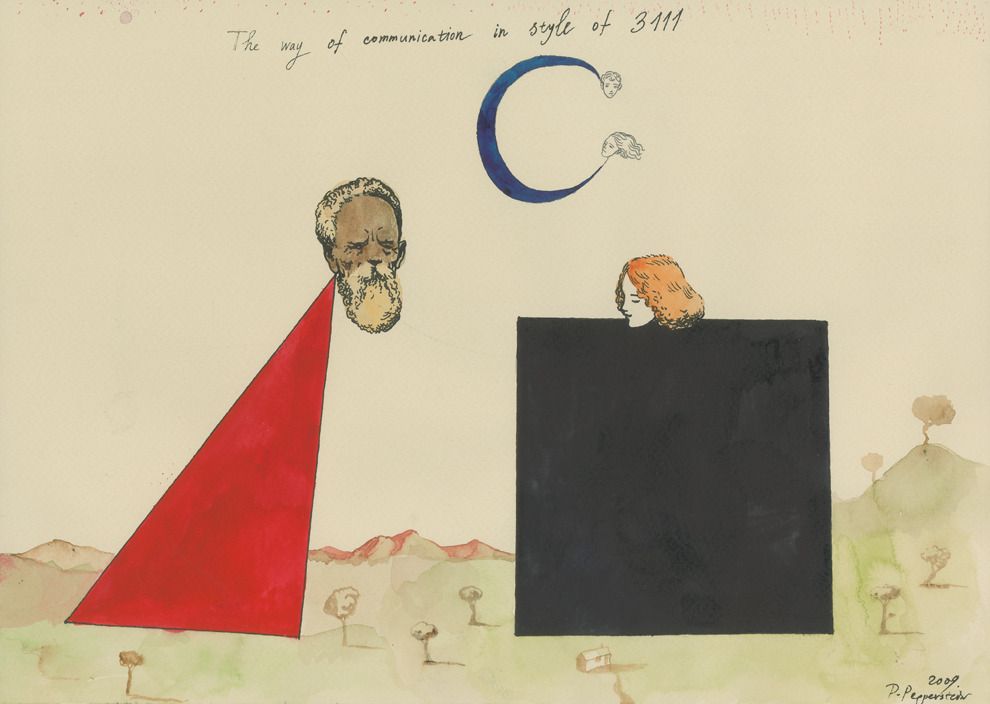
Pavel Pepperstein. The way of communication in style of 3111. 2009. Paper, watercolors
What a grim perspective. Perhaps we could do without totalitarianism, concentrate on conscious consuming and education of spirit, as advocated by Dostoyevsky?
Well, that goes without saying. However, as we know, it is only the spirit of a small number of people that can be educated in any way; with everybody else, you just cannot change their nature. They will stay the way they are. For this reason, we will still be forced to change the structure. As it says in the Scripture, people should not be tempted. It would be pointless to expect them not to give in to temptation. Of course they will yield to any temptation.
People should finally become aware that insane lunatics is what they are. Accordingly, certain methods of therapy should be developed, both individual and collective, and ecological necessities should be covered by this therapy among other things.
We can imagine that the planet also behaves like a diseased organism which responds to the attack of viruses by raising its temperature. In our case, it is man who plays the role of a virus. The planet is angry; she does not like humans, their activities, and she is heating up to get rid of this adversity. Therefore, to get in the good books of the biological environment, we must somehow charm her, appease her. In ancient times, people knew how to flatter the gods, propitiate them, but later we lost this skill somehow. Today, at this new stage, we should treat the Earth as an ailing deity and pray with all our heart for her to heal herself. And theoretically she should find the thing proposed by Greta pleasing. As for Greta herself, I think the Earth likes her.
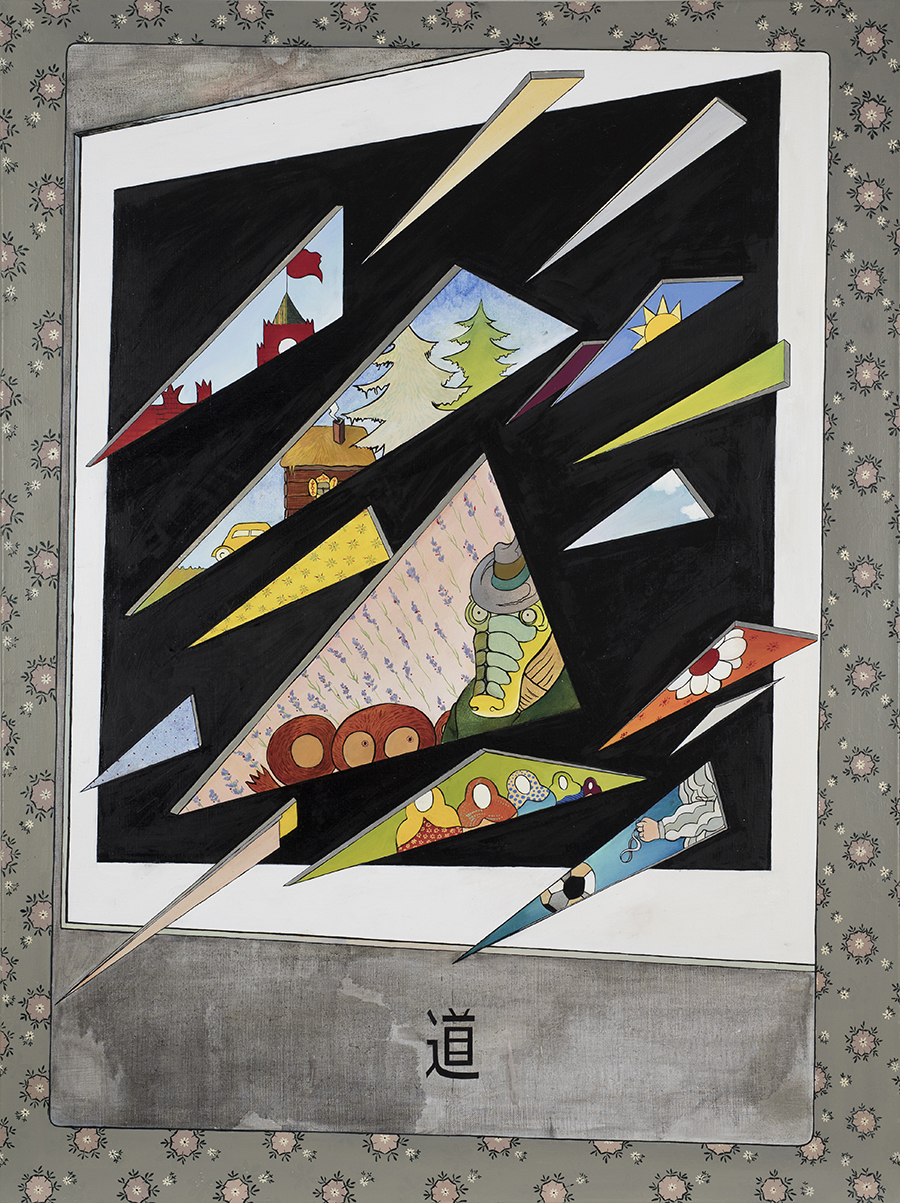
Pavel Pepperstein. Tao. From the series “Philosophical Categories”. 2018. Canvas, oil
Will there be place for art?
Depending on what the designated authorities will decide.
Actually, it will be business as usual. There will be some designing to do, all sorts of posters to make, Kukryniksy-style cartoons: crush the face of British Petroleum with a green boot, that sort of thing. Basically, if we poke deeper inside any progressive installation or exhibition of contemporary art dedicated to topical problems, what we will find there are the same old Kukryniksy ‒ in a different package. There is no difference whatsoever, except Kukryniksy were better, because they were radically cool draughtsmen.
I thought it was not necessary to be a cool draughtsman today?
Perhaps not necessary, but that changes nothing. Art has always been the loyal service staff to the dominating ideology. Hence, if the dominating ideology is ecologically-minded, art will be its servant.
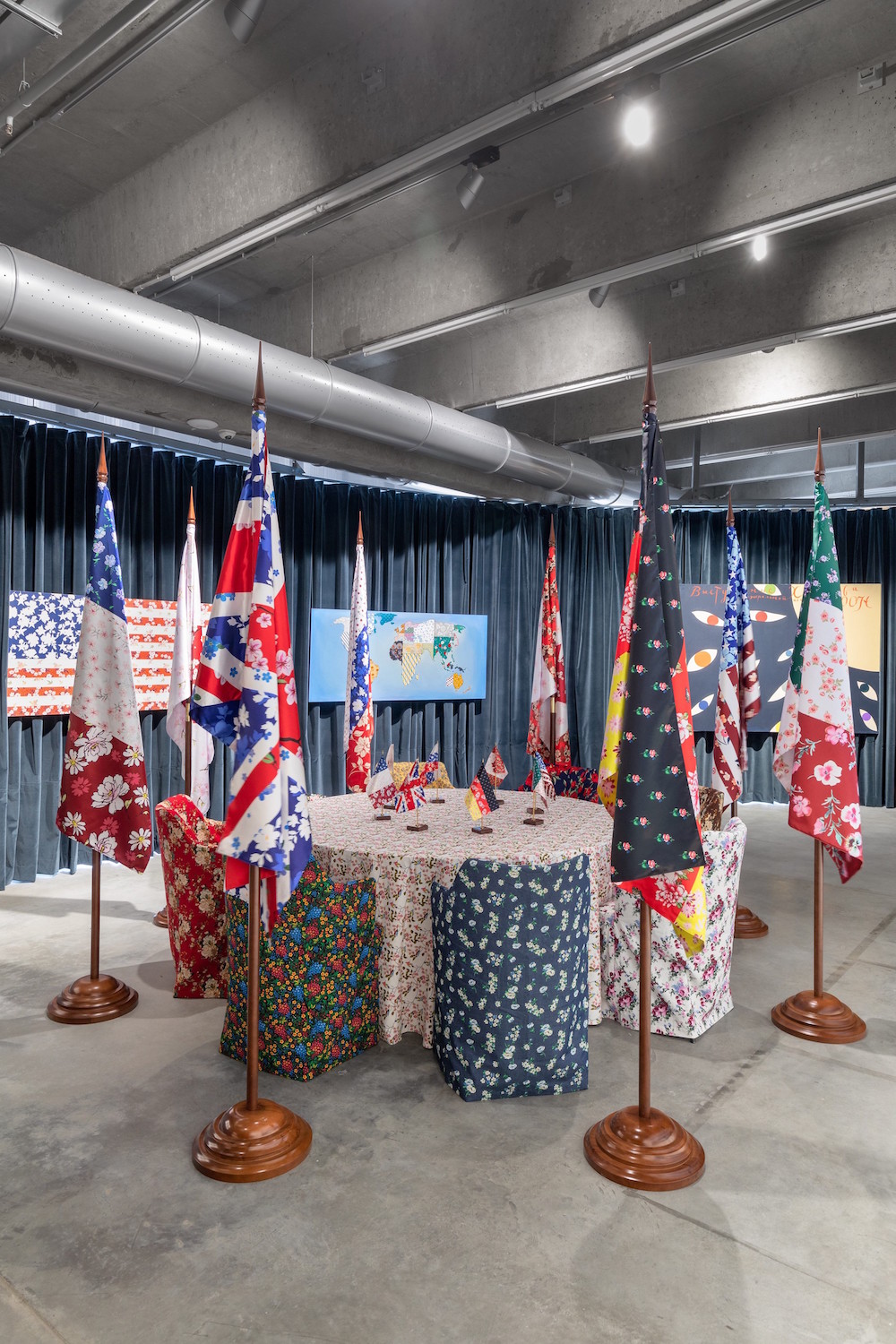
Exhibition by Pavel Pepperstein “Human being as a frame of the landscape” in the Modern Art Museum “Garage”. Photo: Ivan Erofeev
Perhaps art should try on the role of Greta?
To an extent, art is indeed trying to play the role of Greta; nevertheless, I would not pin my hopes on artists. Artists only think of themselves, they live inside their personal psychosis. So it’s pointless to expect them to make a serious effort of saving somebody else. Have artists ever been known to save someone? Never, no-one. They cannot even save themselves. They are narcissistic and deeply troubled people, they’re bonkers. On the contrary, it is they who should be saved, like seagulls, tortoises or pelicans stuck in oil. But if you provide them with a clearly defined task, if you tell them that this is the current line of strategy authorised by the party, now go forth and turn out a nice range of eco-propaganda ‒ yes, they will absolutely do it. Of course, they will think up something beautiful; they are a bunch of people with a wealth of imagination ‒ they will deliver. But they are unable to do anything without any guidelines.
Essentially, we need to look for a way of our own insistently. Greta acts according to an extremely ancient pattern; she touches some profoundly archaic layers populated by all sorts of truth-uttering characters, like oracles, sibyls and holy fools. Bruegel’s Mad Greta immediately springs to mind. She is being listened to, and thank God for that. It must be the work of the biosphere; it must have invented a girl like that. The biosphere actually has countless ways of achieving things; it has her own agency networks, for instance. Many psychedelic substances can transform a person’s world outlook and world view, directing it toward the ecological side and allowing him or her feel what Greta feels. The environment is attempting to engage people in a dialogue. You can be a sensitive girl like Greta, or you can eat a fly agaric. I am currently illustrating Carroll’s Alice's Adventures in Wonderland for the V-A-C Foundation's children's publishing program. I was obsessed with this fairy-tale as a child, and it deals with exactly the same problems we are talking about right now. There is a mushroom involved and a conversation with a caterpillar, also this thing about very young girls as a communication channel with God. I think that it must be one of the most pleasant hypostases for God.
And still ‒ mystical enlightenment and hopes for a sudden emergence of a global eco-socialist dictatorship aside, how do we deal with this avalanche of problems that is burying us?
The planet is already globalised enough, and it must be through some sort of international structures. In the 1990s, a huge role in the formation of my environmental awareness was played by the fact that I spent some time in Europe, in Germany, where I observed so many things done right, like the Ruhr, previously a horrific hell packed with factories wherever you looked, being transformed into a district of green lawns and universities. And it was from these paradise-like locations that I made two trips to Thailand, in 1995 and 1997. And I saw what had happened these over such a short time, I saw the ultimate hell into which this fertile and flowering land had been turned by the same corporations and holding companies that were making the Ruhr beautiful.
All of this can be and must be controlled. All these corporations are nesting in the West and they are inevitably doing their thing, because there is always this doomed mechanistic streak in capitalists. Lenin used to say ‒ the bourgeois are so mechanistic that if you asked them to sell you a rope for hanging them, they would sell it to you happily, because there is simply no other way for them. They are like a wind-up bird that just hops and hops, and hops. And so there have to be structures that do not allow them to do that. In other words, build a wall, and the bird will hop away into a different direction. Until there is no wall, it will hop to the place where there is the best profit. Once the wall is built, the bird will instantly turn out to be very good. It will come up with environmentally friendly methods of production; it will deal with it beautifully.
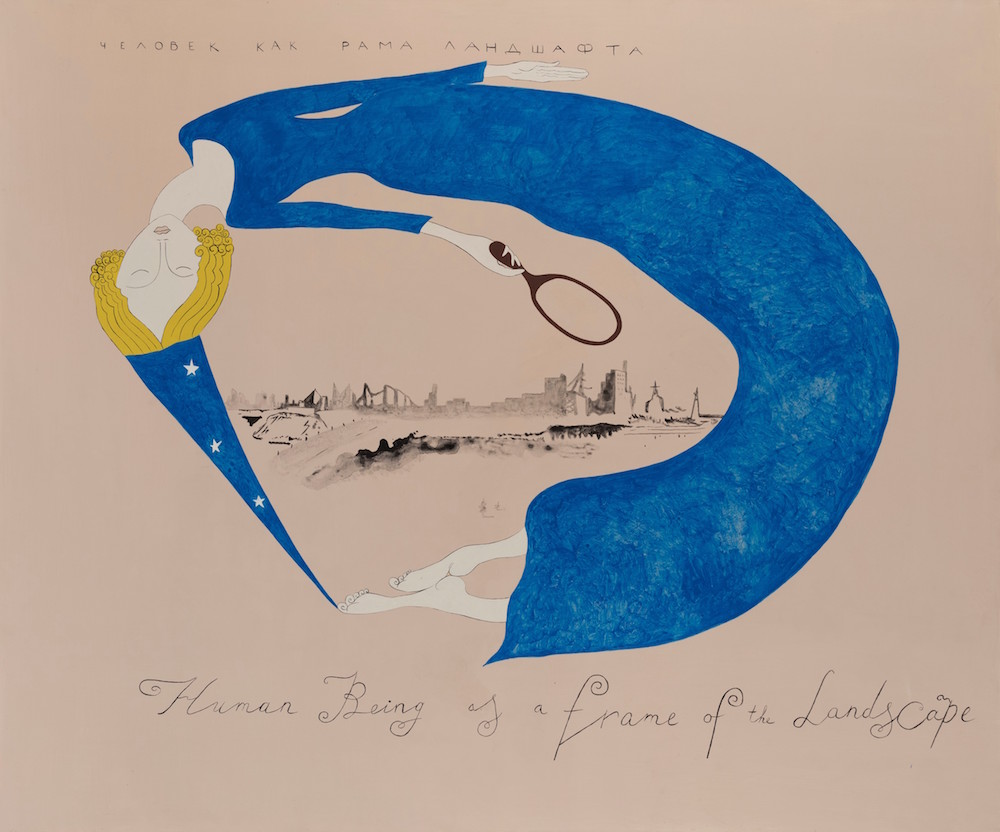
Pavel Pepperstein. Fairy being as a frame of the landscape. 2018. Acrylic, canvas
And artists will help it.
And artists will design the whole thing, they are great at designing. They are what they are.